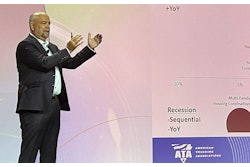Everyone would agree that drivers of heavy trucks should undergo actual training in a vehicle on a street or highway. And yet, no federal regulation requires that they do so. Presumably, a prospective driver would need that training to pass a commercial driver’s license test. But that’s no guarantee of adequate training.
Last month, a federal appeals court in effect ordered the Federal Motor Carrier Safety Administration to rewrite its new minimum training standards for entry-level drivers to require on-street training. It’s now time for FMCSA and the trucking industry to accept that a certain amount of training behind the wheel is necessary.
The rule adopted last year assumes that drivers passing the CDL test receive adequate training for skills tested. In fact, FMCSA’s proposed rule declared that requiring training in those areas “would be redundant.” Instead, the agency focused on four areas – driver qualifications, hours-of-service rules, wellness and whistleblower protection – not covered by the CDL test.
It may seem peculiar that a rule dictating minimum standards for driver training doesn’t address, well, driver training. After all, none of those four topics addresses skills critical to the safe maneuvering of a truck.
This strange result makes more sense, however, when you understand the unusual political and legal environment that produced it. In 1995, the Federal Highway Administration – FMCSA’s predecessor – issued a study concluding, among other things, that any adequate training must include “on-street hours” of training. FHWA sought comments on the study and then did nothing.
A 2002 lawsuit filed by safety advocates demanded the prompt completion of several long-overdue rulemakings, including entry-level driver training standards. The Department of Transportation opted to settle rather than fight and complied by issuing a rule that reads like it was intended to accomplish as little as possible.
FMCSA’s attempt to satisfy the legal settlement in form but not substance failed. Now the agency should tackle the issue squarely by adopting as the minimum standards either the model curriculum for driver training that FHWA published in 1985 or the minimum training standards developed by the Professional Truck Driver Institute. PTDI standards would be the more expedient solution since the organization already certifies truck driving schools’ training programs to its standards.
Motor carriers will object that they could be forced to spend thousands to retrain a driver who already has been trained adequately. But FMCSA could ease those concerns by declaring that drivers who graduate from driver training programs certified to PTDI standards have met the agency’s standard. That safe harbor should strongly encourage carriers to hire graduates of PTDI-certified programs. Truck driving schools likely would rush to obtain certification since their graduates would be in greater demand than those of noncertified programs.
There remains the question of whether to require training of recently hired drivers. Safety advocates and FMCSA should take a long-term and economically reasonable view and simply accept a grandfathering of drivers who are working today and who will be hired during an appropriate transition period that will give truck driving schools time to obtain PTDI certification. Otherwise, the rule inevitably will be tied up in court and in Congress for years, and the result – a delay in implementation – will be the same.
The issue of driver training will not go away, and the trucking industry’s critics have the upper hand. Rather than fight, the industry should embrace a solution that ensures drivers are trained properly the first time.




![Volvo Vnl Sleeper Review[20]](https://img.ccjdigital.com/mindful/rr/workspaces/default/uploads/2025/11/volvo-vnl-sleeper-review20.lrVppY9UDR.jpg?auto=format%2Ccompress&fit=crop&h=167&q=70&w=250)



